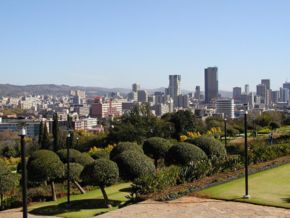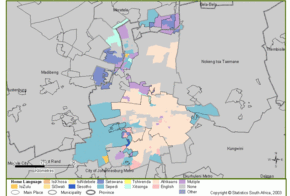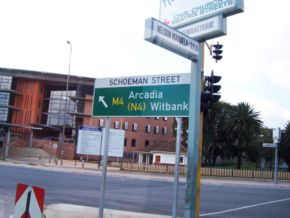Pretoria
2007 Schools Wikipedia Selection. Related subjects: African Geography
|
|||||
| City motto: Praestantia Praevaleat Pretoria (May Pretoria Be Pre-eminent In Excellence) | |||||
| Province | Gauteng | ||||
| Area - % water |
1,644 km² 0.00% |
||||
| Population - Total ( 2005) - Density |
Not ranked 1,884,046 856/km² |
||||
| Established | 1855 | ||||
| Time zone | SAST ( UTC+2) | ||||
| Calling code | 012 | ||||
Pretoria is a city located in the northern part of Gauteng Province, South Africa. It is one of the country's three capital cities, serving as the executive (administrative) capital; the other two being Cape Town and Bloemfontein, respectively the legislative and judicial capitals.
Pretoria is contained in the City of Tshwane Metropolitan Municipality as one of several constituent former administrations (among which also Centurion and Soshanguve), and therefore sometimes incorrectly referred to as Tshwane — this contentious issue is still being decided as of January 2006; see the discussion further down in this article.
Pretoria is town twinned with Washington, D.C., United States.
Change of name
On 26 May 2005 the South African Geographical Names Council (SAGNC), which is linked to the Directorate of Heritage in the Department of Arts and Culture, approved changing the name of Pretoria to Tshwane, which is already the name of the Metropolitan Municipality in which Pretoria, and a number of surrounding towns are located. Although the name change has been approved by the SAGNC, it has not yet been approved by the Minister of Arts and Culture, Pallo Jordan, as of 31 March 2006. The matter is currently under consideration while he has requested further research on the matter. Should the Minister approve the name change, the name will be published in the Government Gazette, giving the public opportunity to comment on the matter. The Minister can then refer the public response back to the SAGNC, before presenting his recommendation before parliament, who will vote on the change. Various public interest groups have warned that the name change will be challenged in court, should the minister approve the renaming. The long process involved made it unlikely the name would change in 2006, even assuming the Minister had approved the change early in the year 2006.
Geography and climate
Pretoria is situated in the transitional area between the Highveld and the Bushveld, approximately 50 km north of Johannesburg in the north-east of South Africa. It lies in a warm, well sheltered, fertile valley, surrounded by the hills of the Magaliesberg range, 1,370 m (4,495 ft) above sea level. The city's coordinates are approximate
| Jan | Feb | Mar | Apr | May | Jun | Jul | Aug | Sep | Oct | Nov | Dec | Year | ||
|---|---|---|---|---|---|---|---|---|---|---|---|---|---|---|
| Highest recorded temperature ( °C) | 36 | 36 | 35 | 33 | 29 | 25 | 26 | 31 | 34 | 36 | 36 | 35 | 36 | |
| Average daily maximum temperature ( °C) | 29 | 28 | 27 | 24 | 22 | 19 | 20 | 22 | 26 | 27 | 27 | 28 | 25 | |
| Average daily minimum temperature ( °C) | 18 | 17 | 16 | 12 | 8 | 5 | 5 | 8 | 12 | 14 | 16 | 17 | 12 | |
| Lowest recorded temperature ( °C) | 8 | 11 | 6 | 3 | -1 | -6 | -4 | -1 | 2 | 4 | 7 | 7 | -6 | |
| Average monthly precipitation ( mm) | 136 | 75 | 82 | 51 | 13 | 7 | 3 | 6 | 22 | 71 | 98 | 110 | 674 | |
| Average number of rain days (>= 1 mm) | 14 | 11 | 10 | 7 | 3 | 1 | 1 | 2 | 3 | 9 | 12 | 15 | 87 | |
| Source: South African Weather Service | ||||||||||||||
Demographics
The city has a population of approximately one million. The main languages spoken in Pretoria include Tswana, Ndebele, Afrikaans, and English. The whole Tshwane Metropolitan Municipality had a population of 1 985 997 as at the 2001 census.
| Language | Population | % |
|---|---|---|
| Sepedi | 439 732 | 22.14% |
| Afrikaans | 422 866 | 21.29% |
| Setswana | 339 719 | 17.11% |
| Xitsonga | 198 441 | 9.99% |
| IsiZulu | 151 200 | 7.61% |
| English | 129 923 | 6.54% |
| IsiNdebele | 98 077 | 4.94% |
| Sesotho | 78 435 | 3.95% |
| SiSwati | 37 963 | 1.91% |
| IsiXhosa | 37 957 | 1.91% |
| Tshivenda | 35 242 | 1.77% |
| Other | 16 425 | 0.83% |
History
Nguni-speaking settlers, who later became known as the Ndebele (derived from the Sotho word for 'refugees'), were probably the first people to recognise the suitability of the river valley which was to become the location of the future city of Pretoria for settlement.
During the difaqane in Natal, another band of refugees arrived in this area under the leadership of Mzilikazi. However, they were forced to abandon their villages in their flight from a regiment of Zulu raiders in 1832.
Pretoria itself was founded in 1855 by Marthinus Pretorius, a leader of the Voortrekkers, who named it after his father Andries Pretorius. The elder Pretorius had become a national hero of the Voortrekkers after his victory over the Zulus in the famous Battle of Blood River. Andries Pretorius also negotiated the Sand River Convention ( 1852), in which Britain acknowledged the independence of the Transvaal. It became the capital of the South African Republic (ZAR) on 1 May 1860.
The founding of Pretoria as the capital of the South African Republic can be seen as marking the end of the Boers' settlement movements of the Great Trek.
During the First Boer War, the city was besieged by Republican forces in December 1880 and March 1881. The peace treaty which ended the war was signed in Pretoria on 3 August 1881 at the Pretoria Convention.
The Second Boer War ( 1899 to 1902) resulted in the end of the South African Republic and start of British hegemony in South Africa. During the war, Winston Churchill was imprisoned in the Staats Model School in Pretoria but escaped to Mozambique. The city surrendered to British forces under Frederick Sleigh Roberts, 1st Earl Roberts on 5 June 1900 and the conflict was ended in Pretoria with the signing of the Peace of Vereeniging on 31 May 1902.
The Boer Republics of the ZAR and the Orange Free State were united with the Cape Colony and Natal Colony in 1910 to become the Union of South Africa. Pretoria then became the administrative capital of the whole of South Africa, with Cape Town the legislative capital. Between 1860 and 1994, the city was also the capital of the province of Transvaal, superseding Potchefstroom in that role.
On 14 October 1931, Pretoria achieved official city status. When South Africa became a republic in 1961, Pretoria remained its administrative capital.
After the creation of new municipal structures across South Africa in 2000, the name Tshwane was adopted for the Metropolitan Municipality that includes Pretoria and surrounding towns.
Pretoria previously had an image as "the capital of Apartheid South Africa". However, Pretoria's political reputation was changed with the inauguration of Nelson Mandela as the country's first black President at the Union Buildings in the same city. However, the name Pretoria still has a negative connotation to some black South Africans, and therefore a change of name to Tshwane has been proposed. This proposed change is controversial to the many inhabitants of the city, especially the Afrikaner community, to whom the name Pretoria has an important historical relevance.
One example of the image of Pretoria abroad was the derisive nickname Pretoria-Gasteiz for Vitoria-Gasteiz in Negu Gorriak's song Napartheid.
Cultural and academic
Pretoria is one of South Africa's leading academic cities, and it is home to both the largest residential university in the country (the University of Pretoria), the Tshwane University of Technology and the largest distance education university (the University of South Africa, more commonly known by its initials, UNISA). The South African Council for Scientific and Industrial Research (CSIR) is also located in this city.
One of the most popular sports in Pretoria is rugby union. Loftus Versfeld is home to the Blue Bulls who compete in the domestic Currie Cup, and the Bulls who compete in the international Super 14 competition. Pretoria also hosted matches during the 1995 Rugby World Cup. Loftus and Rainbow Junction will be used for matches of the 2010 World Cup.
Economy
Pretoria is an important industrial centre, with heavy industries including iron and steel casting as well as automobile, railroad and machinery manufacture. In a study entitled An Inquiry into Cities and Their Role in Subnational Economic Growth in South Africa and published in 2002 by statisticians at Potchefstroom University, the city was found to contribute 8.55% of the country's total GDP, making it the third biggest contributor behind Johannesburg and Cape Town.
Places of interest
- The National Zoological Gardens of South Africa
- Kruger House (Residence of the president of the ZAR, Paul Kruger).
- Melrose House (The Treaty of Vereeniging which ended the Anglo-Boer War was signed here in 1902)
- Church Square
- Union Buildings
- Voortrekker Monument
- Freedom Park
- Marabastad
- Transvaal Museum
- African Window
- Menlyn Park
Trivia
- Pretoria's main street, Church Street, is the longest urban street in South Africa and one of the longest straight streets in the world.
- Many of the city's streets are lined with Jacaranda trees that blossom mauve (purplish blue) in spring, giving rise to the city's nickname "Jacaranda City".
- The Cullinan Diamond (the largest gem diamond ever found) was discovered in the town of Cullinan near Pretoria at the Premier Mine on January 26, 1905.
- Pax Praetoriana was named after Pretoria.
- The initial full designation of the city was Pretoria Philadelphia (‘Pretoria of brotherly love’).





